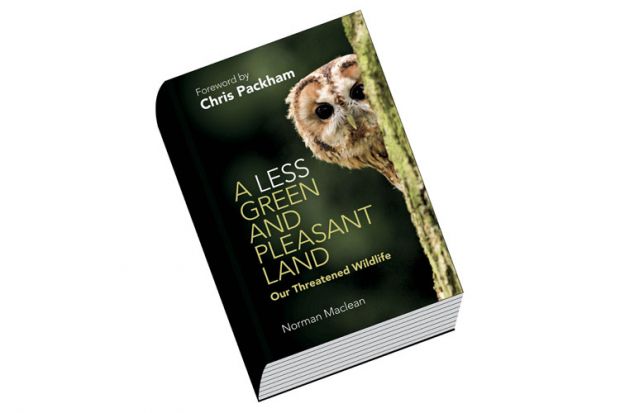In the 1930s, the naturalist and writer D. W. Gillingham walked far fields and forests in south Essex where now thunders the M25. In Unto the Fields, he wrote of a land dense with wildlife. “The ploughland flickered with birds; an immense flock of chaffinches and yellow hammers, together with larks, and crows and stockdoves and chack-chacking fieldfares and lapwings, so much life, indeed, that I could not observe it all at once.” He saw a flock of 80 bramblings, and gatherings of tits on the forest floor rustling so loud he thought they were deer. His stories illustrate a concept now called shifting baseline syndrome: we tend to assume that normal levels are those that we experienced at a particular point in the past. Yet if we look further back, we often find the losses to have been much worse.
In this important book about an assumed once-pleasant land, biologist Norman Maclean runs his expert eye over the state of Britain’s nature. There are vignettes of place, reflections on introductions deliberate and accidental, and concerns about racing climate change. What is apparent is the entanglement of the wild and gardened/farmed, and how change in one species can unravel whole systems. One of the first butterflies of spring in southern England is the orange comma: it came close to extinction in the 1930s because it laid its eggs on hops, and fewer were being cultivated. But then it switched to lay on nettle and elm, and adult numbers rebounded; then the elm was wiped out as a tree in the 1970s. In your garden, you will still hear the rasps of grasshoppers come summer afternoons, but the chirps of house crickets are long extinct in our sterile homes.
It is clear that no part of our land is solely wild, and none just domestic. What we see is shaped by our choices and interventions. And this means values matter. Maclean documents the good and bad, the old and new, the rare and common species. How odd that we become more interested in species as they become rarer. The house sparrow was once disparaged as far too common; now it has edged close to extinction and we care for it more. The plucky red squirrel was once just a forest mammal, but it was pushed out by invader greys. If greys were to become suddenly rare, maybe we would like them more.
It is on values that this book is revealing. Maclean calls some plants true undesirables (Japanese knotweed, giant hogweed); others welcome neophytes (turkey oak, London plane), or even attractive neophytes (snake’s head fritillary, evening primrose). He reflects favourably on the “successful extermination” of the coypu. I remember that last coypu, gone in the late 1980s: culturally celebrated in Norfolk and Suffolk, and their loss painfully felt despite the fact that they had become in official eyes a bad species.
How then, perhaps, to use such values to good effect? How can we romance a population to love nature more? Maclean notes how Kenneth Grahame’s The Wind in the Willows, just a children’s novel, did so much for water voles. In days gone by, most rural children collected birds’ eggs – a pastime that is now illegal. Yet that hobby increased understanding and respect that lasted a lifetime. What has replaced egg collecting in today’s generations? Sadly not much outdoors, and this extinction of experience is perhaps one of the greatest threats to wildlife.
Gillingham did not know that his lands would become impoverished. He walked and wrote. This is good business, and repeated today could help keep those blue-remembered hills of our childhoods and pasts vivid and meaningful. It might mean that we act more to save what is important.
Jules Pretty is professor of environment and society, University of Essex. He is author, most recently, of This Luminous Coast (2011) and The Edge of Extinction: Travels with Enduring People in Vanishing Lands (2014).
A Less Green and Pleasant Land: Our Threatened Wildlife
By Norman Maclean
Cambridge University Press, 424pp, £16.99
ISBN 9781107673236 and 9781316057544 (e-book)
Published 21 May 2015
POSTSCRIPT:
Review originally published as: If you go down to the woods today (4 June 2015)
Register to continue
Why register?
- Registration is free and only takes a moment
- Once registered, you can read 3 articles a month
- Sign up for our newsletter
Subscribe
Or subscribe for unlimited access to:
- Unlimited access to news, views, insights & reviews
- Digital editions
- Digital access to THE’s university and college rankings analysis
Already registered or a current subscriber?
